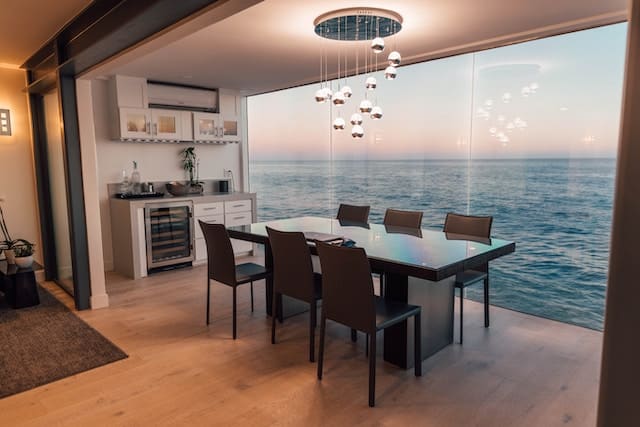Introduction – Sustainable Interior Design
An often overlooked aspect of reducing our carbon footprint is through sustainable interior design. This article aims to provide a sophisticated layman with an overview of sustainable materials and practices that can be incorporated into interior design projects, featuring real-life examples and insights from industry experts.

Sustainable Interior Design Principles
Sustainable interior design goes beyond aesthetics; it focuses on creating spaces that are not only beautiful but also environmentally responsible. Key principles to consider when designing with sustainability in mind include energy efficiency, waste reduction, and lifecycle assessment. Renowned eco-conscious designer Oliver Heath explains, “By incorporating these principles, we can create spaces that not only look good but also have a positive impact on the environment and our well-being.”
Eco-friendly Materials For Interior Design
Selecting sustainable materials for interior design is an important aspect of reducing your home’s environmental impact. A great example of this can be seen in the award-winning eco-home of designer Sarah Barnard, who prioritizes the use of natural and sustainable materials. Below we give examples of sustainable interior design materials.
- Reclaimed wood: Companies like Urban Wood Goods offer reclaimed wood furniture made from salvaged lumber, reducing the need for new timber and minimizing waste.
- Bamboo: This fast-growing, renewable resource can be used in flooring, cabinetry, and furniture. Brands like Plyboo offer sustainable bamboo products for various interior design applications.
- Cork: Sustainable and versatile, cork can be used for flooring, wall coverings, and even furniture. Companies like Amcork offer cork-based interior design products.
- Natural fibers: Consider textiles made from linen, organic cotton, or wool for upholstery, fair trade rugs, and sustainable curtains and eco-friendly curtains. Brands like Coyuchi and Boll & Branch offer eco-friendly textiles.
For an even greener approach, opt for recycled or upcycled materials:
- Recycled glass: Brands like Icestone create stunning countertops and surfaces from recycled glass, reducing waste and promoting sustainability.
- Recycled metal: Look for products made from recycled metal, such as aluminum or steel, to reduce resource consumption.
- Reclaimed furniture and decor: Repurpose vintage or second-hand items to give them a new life, or shop from brands like The Old Cinema that specialize in restored furniture.
Green Interior And Efficient Energy Design Practices
Energy use in a home contributes about a third of emissions, after food and transportation. Therefore, it stands to reason that energy-efficient interior design plays a significant role in reducing carbon emissions and overall energy consumption in a home. By implementing design strategies such as optimizing natural light, using energy-efficient lighting like LED bulbs, and selecting Energy Star-rated appliances, you can significantly decrease your home’s energy use. Sustainable interior design also involves making smart choices when it comes to lighting, finishes, and space utilization:
- Choose energy-efficient lighting and appliances, such as LED bulbs and Energy Star-rated products.
- Select low-VOC paints and finishes to improve indoor air quality. Brands like Benjamin Moore offer eco-friendly paint options.
- Incorporate natural light and ventilation to reduce energy consumption. Architect Michelle Kaufmann suggests utilizing skylights and passive solar design to maximize natural light.
- Maximize space utilization to improve efficiency, making your home feel more spacious and reducing the need for additional furniture and accessories.
Moreover, proper insulation, double or triple-glazed windows, and the use of passive solar design principles can help maintain a comfortable indoor temperature, reducing the reliance on heating and cooling systems. These energy-saving measures not only contribute to lowering carbon emissions but also result in financial savings through reduced energy bills, making energy-efficient interior design a practical and eco-friendly choice for homeowners.
Sustainable Interior Design Trends – 2023
Embrace these sustainable interior design trends to create a stylish and eco-conscious space:
- Biophilic design: Connect with nature by incorporating plants, natural materials, and organic shapes into your interior design. Australian architect and biophilic design expert Amanda Sturgeon emphasizes the importance of “creating spaces that nurture and support our physical, emotional, and mental well-being.”
- Minimalist design and decluttering: Emphasize simplicity and functionality while reducing waste and excess.
- Multi-functional and adaptable furniture: Choose furniture that can serve multiple purposes, like sofa beds or expandable dining tables, to reduce resource consumption.
- Support local and eco-conscious businesses: Purchase from brands that prioritize sustainability and ethical practices, like West Elm’s Fair Trade Certified collections
Tips For Success
Assess your home’s current sustainability level to identify areas for improvement. Begin by evaluating the materials, finishes, and appliances already in place, and consider how you can make eco-friendlier choices.
Set achievable sustainability goals for your interior design project. Start small and gradually work towards incorporating more sustainable materials and practices into your home.
Collaborate with eco-friendly designers and architects to create a truly sustainable space. They can provide invaluable expertise and guidance throughout the process.
Continuously learn and adapt to new green innovations, such as sustainable materials and energy-saving technologies. Stay informed about the latest advancements in sustainable interior design to ensure your home remains as eco-friendly as possible.
Personal Experiences and Conclusion – Sustainable Interior Design Materials
As someone who has embarked on the journey of creating a more sustainable home, I can attest to the benefits of embracing sustainable interior design. Not only does it have a significant impact on reducing your carbon emissions, but it also creates a more comfortable and aesthetically pleasing living environment.
By incorporating sustainable materials and practices into your home’s design, you contribute to a healthier planet and a better future for all. The real-life examples and expert insights shared in this article serve as an inspiration for anyone looking to create a greener, more sustainable space. Remember, every small step counts toward a more sustainable future. So start your sustainable design journey today and make a lasting, positive impact on the environment and your well-being.

Anne Lauer
Anna Lauer is a writer, gardener, and homesteader living in rural Wisconsin. She has written for Mother Earth News, Grit, and Hobby Farms magazines. Anna is writing a new book about growing your food for free and an ultimate guide to producing food at little to no cost. When she’s not writing or gardening, Anna enjoys spending time with her husband and two young daughters.
